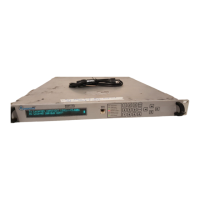AMT-70/AMT-73/AMT-75 Installation and Operation
The internally generated transmit clock (ST) is used to clock the data out of the Doppler Buffer. A
complex scheme allows the Doppler buffer to start from the center, then as the Demod Clock varies
due to the diurnal of the satellite movement, it will vary + and - around center to maintain the bit
integrity of the output data (RD) without any Doppler shift.This mode is entered by selecting
IFRXCLOCK local (SCT).
3.5.2.3 Doppler Buffer Enabled – External TT Clocking (SCTE)
The externally generated transmit clock (TT) is used to clock the data out of the Doppler Buffer. A
complex scheme allows the Doppler buffer to start from the center, then as the Demod Clock varies
due to the diurnal of the satellite movement, it will vary + and - around center to maintain the bit
integrity of the output data (RD) without any Doppler shift.
This mode is entered by selecting IFRXCLOCK DTE TT (SCTE).
3.6 Loop-back, Pure Carrier, and BER Test Functions
The AMT-70 and AMT-73L includes three built-in loop-back functions that allow maintenance functions
to be performed on the modem and external circuitry. There are two data loop-back functions and one
IF loop-back function. Activating the either of the two data loop-back functions (either/or) invokes a
near end or a far end loop-back. The IF loop-back is only a local (near end) loop-back. Loop-backs are
a keen method of isolating a problem to a particular area.
Both modems support the activation of a pure carrier, which allows offline testing of the modulator
output, such as phase noise, frequency accuracy. Caution should be taken in the activation of a pure
carrier node, since it places all of the energy into a single frequency. This may cause interference
problems with others sharing the satellite transponder.
The AMT-70 and AMT-73L include a built-in BER generator and tester that allow a maintenance
operator to thoroughly test modem before placing it on line. While in this mode, the modem is
effectively off line, since the modulator will produce a test pattern polynomial, and, to be effective, the
demodulator will test that test pattern with one of its stored polynomials.
3.6.1 Data Interface Near End/Far End Loop-back
The data interface loop-back is directly at the input of the interface. When activated, the near end
Interface loop-back returns the transmit data (TD) and clock (TT) directly to the receive data (RD) and
receive clock (RT) without going through any active components. The far end loop-back (both are
activated simultaneously) sends RD and RT to TD and TT, respectively. Testing at the far end modem
therefore tests both modems completely.
The near end mode is entered by selecting IFLOOPMODE line local. The far end mode is entered by
selecting IFLOOPMODE line far.
54
Warning:
Invoking any of the loopback, Pure Carrier, and BER test functions will
cause the modem to disrupt normal traffic through the modem. These
tests should only be performed with the modem placed offline.

